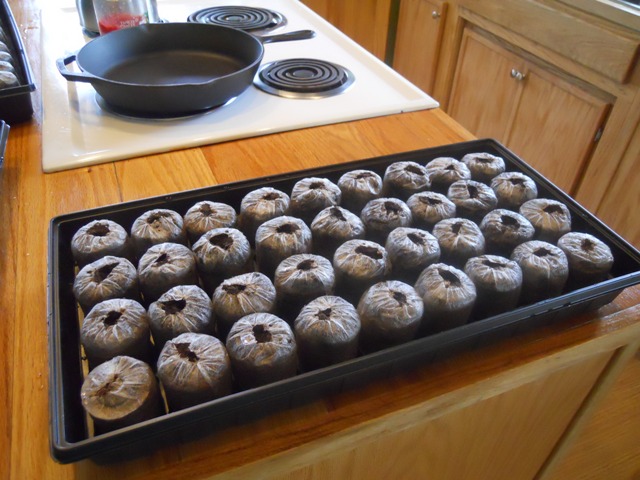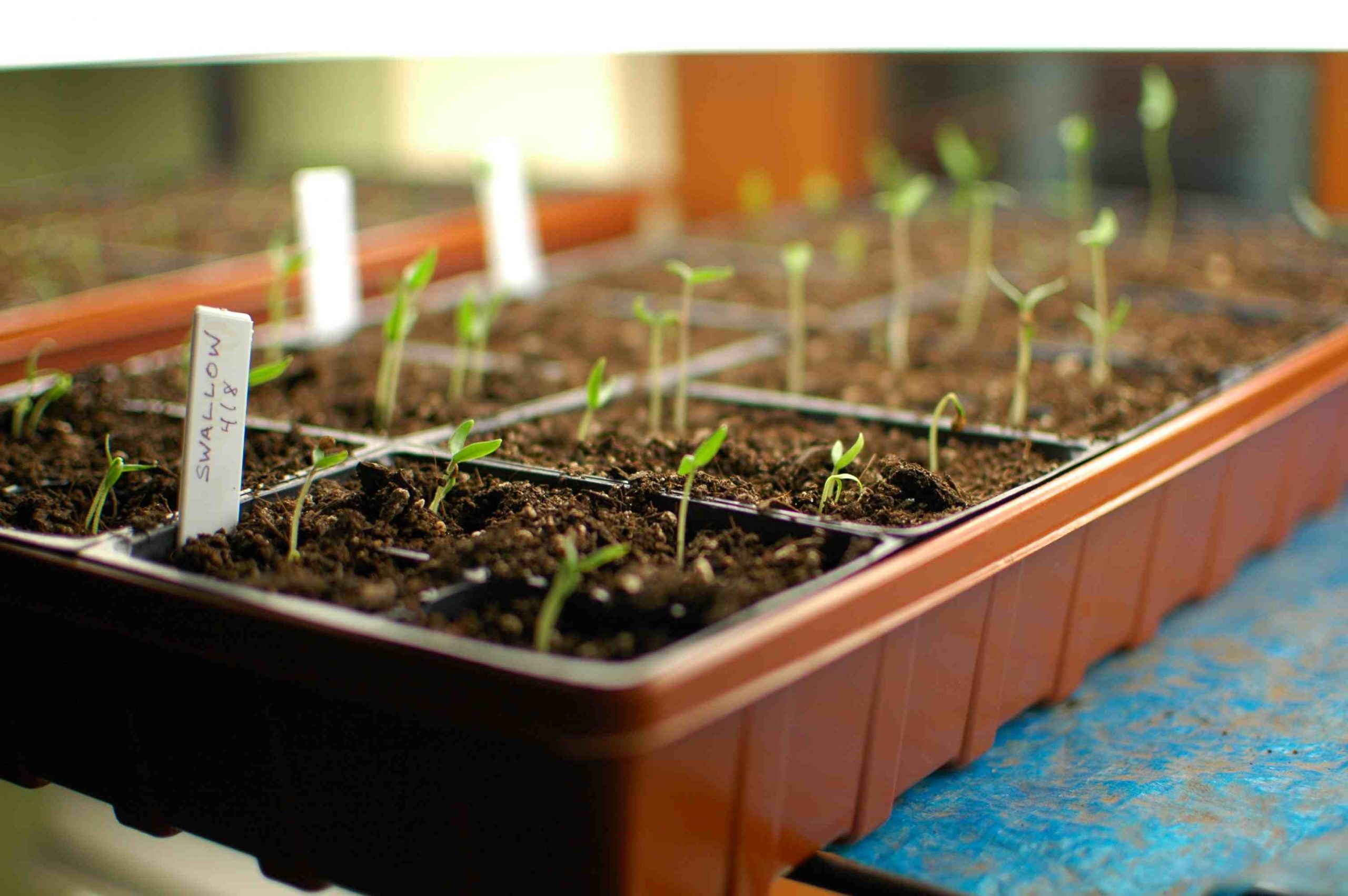This season makes my head spin! There is so much going on in the garden in the spring. Just this weekend, we transferred our tomatoes to our outdoor garden area. In honor of the holiday, I’ll show you how to start tomato plants indoors before moving them outside. This step-by-step how-to guide includes pictures and gardening tips for a successful tomato harvest.
Starting tomato seeds directly outside in the garden can be tempting for its simplicity. Just poke some seeds in the ground and let nature take its course, right? Unfortunately, it’s not quite that easy in most climates. Tomatoes require a long warm growing season to set fruit. Trying to start seeds outdoors leaves you at the mercy of your region’s weather and often results in disappointing yields. But with some planning and patience, it is possible. Here’s what you need to know about starting tomato seeds outside.
When is it Feasible to Direct Seed Tomatoes?
The main factor determining the feasibility of direct seeding is your climate and growing season length. Tomatoes need daytime temps of at least 70°F for seeds to germinate. At night they require at least 60°F. This combination of warm days and nights doesn’t happen until mid to late spring in most regions.
If you live in USDA Hardiness Zones 8-10, you can probably direct seed with success These warmer regions have long enough seasons to still get a good harvest. Everywhere else, the short seasons make getting a jump start indoors a better bet
As a benchmark if your frost-free season is less than 4 months direct seeding is risky. You lose precious time waiting for viable weather. Aim for starting indoors 6-8 weeks before your last expected frost date.
Timing for Direct Seeding Tomatoes
To maximize your odds of success, wait until soil temps reach at least 70°F before seeding. This requires nighttime lows staying above 60°F. In most regions, this doesn’t happen until late May or even June.
The timing varies depending on your exact location. Count back from your first fall frost date, using the days to maturity of the variety you want to grow. Add a couple of weeks as a buffer. This gives you the latest date you can safely seed outdoors.
For example, if your frost date is October 1, and you are growing a variety needing 90 days to produce fruit, you’d want to seed by early August at the absolute latest. Mid July would be safer.
How to Direct Seed Tomatoes
If your climate allows it, direct seeding tomatoes is straightforward:
- Prepare your planting beds and enrich the soil with compost or other organic material. Tomatoes are heavy feeders.
- Wait until day and night temperatures reach the 70°F and 60°F minimums discussed above.
- Poke holes 1⁄4 to 1⁄2 inch deep and 12-18 inches apart in rows.
- Place 2-3 seeds in each hole and cover lightly with soil.
- Water gently daily until seedlings emerge. This can take 7-14 days.
- Once the seeds sprout, thin to leave the strongest seedling.
- Use row covers or cloches to protect young plants if cold snaps occur.
- Mulch once plants are several inches tall to retain moisture and reduce weeds.
- Water deeply and regularly once they start setting fruit. Tomatoes need consistent moisture.
- Add supports like cages or stakes once plants size up.
The Drawbacks of Direct Seeding
While direct seeding sounds simple, it has some notable downsides:
- Delayed maturity: You lose time waiting for viable weather, delaying harvests.
- Poor germination: Fluctuating spring temperatures and moisture cause erratic or poor germination.
- Slow early growth: Cool spring soil and air keep plants growing slowly in early stages.
- Higher risk of disease: Cool, damp soil fosters disease issues like damping off.
- Less total fruit: Plants have less time to mature fruit before frost ends the season.
- Lower quality fruit: Cool nights and periods of heat stress reduce fruit quality.
For these reasons, most gardeners are better off starting tomatoes inside even if direct seeding is technically possible in their area.
Using Season Extenders
If you are determined to direct seed, using season extending methods can help overcome some of the drawbacks:
- Use cloches, tunnels, or cold frames over plants to retain heat, especially at night.
- Switch to black or red plastic mulch once seedlings are established. This warms the soil.
- Use floating row covers to protect from cold snaps.
- For marginal climates, choose extra-early variety tomatoes.
- Allow as much time as possible for fruit to mature before frost.
Even with these aids, direct seeded plants will lag behind those given an earlier start indoors. Weigh whether the extra effort is worth it in your climate.
The Best Approach for Most Gardeners
Starting tomato seeds indoors gives you far greater control and leads to earlier harvests of higher quantity and quality. It allows the use of large-fruited, long-season varieties that couldn’t ripen in time if direct seeded. With reasonable care, indoor seed starting almost always outperforms direct seeding.
But for those in very warm climates or who want the experience of growing from seed outdoors, it can be done. Just be prepared for the challenges and limitations involved. Pay close attention to soil temperature, use season extending methods, and select quick maturing varieties to stack the deck in your favor.
While direct seeding tomatoes isn’t practical for many of us, it’s still a fun experiment for warm regions or gardeners who enjoy a challenge! With careful planning, you can discover for yourself whether it’s a viable option in your own backyard.
How to Start Tomato Seeds Inside
First thing’s first. Find out what planting zone you are in so that you know when to start your seeds and when you should transfer seedlings to your outdoor garden.
Kentucky began our seeds indoors on March 9 and moved the seedlings to our garden on April 11. You should only move seeds to the garden outside when there is no chance that a frost will kill the seedlings. Of course, we know that things happen and we cannot always control the weather.
Purchase the kind of seed you want to use.
 There are many different kinds of tomato seeds to choose from. There are organic, non-GMO, heirloom, or just plain nonspecific seed types. You can choose from many different varieties also. They have cherry tomatoes, Roma tomatoes, beefsteak tomatoes, Early Girls, Better Boys, etc. I recommend researching the different kinds and make a choice based on your needs. Some tomatoes are good for eating fresh while others are good for making sauces and tomato paste.
There are many different kinds of tomato seeds to choose from. There are organic, non-GMO, heirloom, or just plain nonspecific seed types. You can choose from many different varieties also. They have cherry tomatoes, Roma tomatoes, beefsteak tomatoes, Early Girls, Better Boys, etc. I recommend researching the different kinds and make a choice based on your needs. Some tomatoes are good for eating fresh while others are good for making sauces and tomato paste.
Buy Soil and Prepare Seed Beds
We purchased seed trays that had compacted soil in them so we just had to add water. Then we planted our seeds according to the map on the package, which showed how deep the seed should be planted in the ground. If you are using just plain containers and starter soil, make sure your soil is good and wet.
After you have sown seeds, cover trays with a plastic cover or plastic wrap.
 This is important to do because it gives a greenhouse effect to the growing process by trapping moisture inside the container.
This is important to do because it gives a greenhouse effect to the growing process by trapping moisture inside the container.
The plastic cover should be taken off once the seeds have sprouted. Make sure the seedlings get enough water and sunlight while they grow.
The process of the seeds sprouting can take anywhere from 3-7 days.
Best Way to Start Tomato Seeds Indoors (or Outdoors)
FAQ
How long do tomato seeds take to germinate outside?
Can I start tomatoes outdoors?
Do you have to start tomato seeds indoors?
When to put tomato seedlings outside?
Can you plant tomato seeds outside?
Of course you can plant your seeds outside before it’s consistently that warm, but one of two things will probably happen. 1) The tomato seeds will germinate just fine but they will be sickly or just grow extremely slowly, or 2) they won’t germinate at all until the weather is favorable.
How to plant tomato seeds indoors?
As mentioned earlier, the best idea is to start your seeds in containers indoors to get a head start on the season and ensure a healthy growth. Here are the steps you should follow when learning how to plant tomato seeds: Put two or three seeds in each container, leaving space among them. Cover them in a thin layer of soil (or the soilless mix!).
When should I start my Tomatoes indoors?
I like to start my tomatoes indoors 6-8 weeks before the last spring frost date to get a head start on the season. Fill seed starting trays or modular plug trays with a sterile seed starting mix. Following instructions on the seed packet, plant one seed per cell about 1/4 inch deep.
When should I plant tomato seeds?
You can basically plant tomato seeds indoors 6 to 8 weeks before the last spring frost date for your area. This usually works out to be sometime in late winter or early spring. Starting them inside gives the seeds a head start before putting them outside once the threat of frost has passed. How deep should I plant tomato seeds?
- The Ultimate Guide to Growing Strawberries in Raised Beds - August 8, 2025
- No-Dig Garden Beds: The Easiest Way to Grow a Beautiful Garden - August 6, 2025
- How to Protect and Preserve Wood for Raised Garden Beds - August 6, 2025

